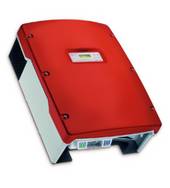Inverters
An inverter is an electronic device which converts direct current into alternate current, at a different tensions or frequencies. In a photovoltaic system inverters are specifically designed to convert direct current from photovoltaic panels into alternate current to be used in the electricity grid. These devices extend the basic workings of a normal inverter to highly sophisticated functions, through the use of specific software and hardware systems, that allow the user to extract the maximum power available from the solar panels under any meteorological conditions.
This function is called MPPT (MAXIMUM POWER POINT TRACTER). The photovoltaic panels, in fact, have a V/1 curve, that provides an optimal point, the so-called Maximum Power Point, whence it is possible to extract all the power from the sun’s rays.
This point varies continuously to catch the radiation beating on the surface of the cells. It is clear that any inverter able to remain locked into this point will always obtain the maximum power available under whatsoever conditions. There are a number of techniques for obtaining the MPPT function differing in terms of performance (settling time) and accuracy. Although the precision of the MPPT is a crucial factor, settling time is, in many cases, even more so. While many inverter makers are able to realise MPPT devices of considerable precision (usually between 99 and 99.6% of available input) only few have been able to marry precision with rapidity.
Indeed, on cloudy days in variable weather conditions, one witnesses sudden and extreme jumps in solar power. It is common to find variations from 100W/m2 to 100-1200W/m2 in less than 2 seconds. In such frequently occurring conditions an inverter with a settling time of less than 5 seconds can manage to produce 5 to10% more energy than a slower version.
Some photovoltaic inverters are equipped with modular power states, and a few actually come with an MTTP for every power state. In this way, the producers leave the engineering system free to calculate the master/slave function or autonomous MPPTs. The use of autonomous MPPTs supplies an objective advantage in conditions of irregular irradiation of the panels. Indeed, it frequently occurs that the surface area of the solar panels is exposed to sunlight in an intermittent manner. This is because the panels are arranged on two sides of the rooftop, because the modules are not distributed on equal strings or because the modules are partly in the shade. In this case the use of only one MPPT would take the inverter away from the maximum energy point and, as a consequence, energy production would suffer.
Another important characteristic of a photovoltaic inverter is how it interfaces with the grid; this function, generally integrated in the machine, must be in line with the norms imposed by the diverse electricity suppliers.
In Italy ENEL’s regulations (norm DK5040 Edition 2.2) impose a series of measures, aimed at preventing the emission of electrical energy outside safety parameters into the grid.
arkesrl@guidogroup.com PEC: info-arke@legalmail.it
C.F. - P.IVA: 03371190780
webdesign SkillGrafica
Registered office: Via L. Ariosto, 3 - 87100 - COSENZA (Italy) - tel. +39 0984 466654
North Italy operative branch: via Tonale, 9 - 20125 - MILANO - tel. +39 02 39289261
Central Italy operative branch: via Sante Bargellini, 4 - 00157 - ROMA - tel. +39 06 83952370
E.S.Co. Arké S.r.l.
PRIVACY POLICY

